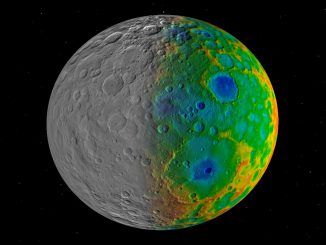
On 23 October, mission operators sent a series of commands to NASA’s Voyager 2 spacecraft for the first time since mid-March. The spacecraft has been flying solo while the 70-metre-wide (230-foot-wide) radio antenna used to talk to it has been offline for repairs and upgrades. Voyager 2 returned a signal confirming it had received the “call” and executed the commands without issue.
The call to Voyager 2 was a test of new hardware recently installed on Deep Space Station 43, the only dish in the world that can send commands to Voyager 2. Located in Canberra, Australia, it is part of NASA’s Deep Space Network (DSN), a collection of radio antennas around the world used primarily to communicate with spacecraft operating beyond the Moon.
Since the dish went offline, mission operators have been able to receive health updates and science data from Voyager 2, but they haven’t been able to send commands to the far-flung probe, which has traveled billions of miles from Earth since its 1977 launch.
Among the upgrades to DSS43, as the dish is known, are two new radio transmitters. One of them, which is used to talk with Voyager 2, hasn’t been replaced in over 47 years. Engineers have also upgraded heating and cooling equipment, power supply equipment, and other electronics needed to run the new transmitters.
The successful call to Voyager 2 is just one indication that the dish will be back online in February 2021.
“What makes this task unique is that we’re doing work at all levels of the antenna, from the pedestal at ground level all the way up to the feedcones at the center of the dish that extend above the rim,” said Brad Arnold, the DSN project manager at NASA’s Jet Propulsion Lab in Southern California. “This test communication with Voyager 2 definitely tells us that things are on track with the work we’re doing.”
The Deep Space Network consist of radio antenna facilities spaced equally around the globe in Canberra; Goldstone, California; and Madrid, Spain. The positioning of the three facilities ensures that almost any spacecraft with a line of sight to Earth can communicate with at least one of the facilities at any time.
Voyager 2 is the rare exception. In order to make a close flyby of Neptune’s moon Triton in 1989, the probe flew over the planet’s north pole. That trajectory deflected it southward relative to the plane of the planets, and it has been heading in that direction ever since. Now more than 11.6 billion miles (18.8 billion kilometres) from Earth, the spacecraft is so far south that it doesn’t have a line of sight with radio antennas in the Northern Hemisphere.
DSS43 is the only dish in the Southern Hemisphere that has a transmitter powerful enough and that broadcasts the right frequency to send commands to the distant spacecraft. Voyager 2’s faster-moving twin, Voyager 1, took a different path past Saturn and can communicate via antennas at the two DSN facilities in the Northern Hemisphere.



